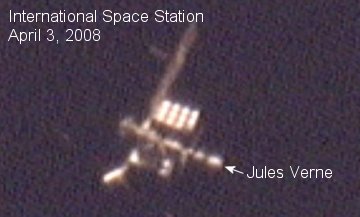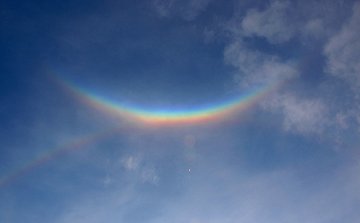| Where's Saturn? Is that a UFO--or the ISS? What's the name of that star? Get the answers from mySKY--a fun new astronomy helper from Meade. | |  | DEPARTING SUNSPOT: Big and old, sunspot 988 is approaching the sun's western limb where it could put on a show as it goes over the horizon. For the next 24 hours or so, any magnetic filaments springing from the sunspot's core will appear in glowing relief against the black void beyond. Readers with solar telescopes, keep an eye on the limb. photos: from Malcolm Park of London, England, UK; from Pete Lawrence of Selsey, West Sussex, UK; from John Stetson of Falmouth, Maine; from Greg Piepol of Rockville, Maryland; from Michael Buxton of Ocean Beach CA; SIGHTINGS: Now that ESA's Jules Verne cargo carrier has docked to the International Space Station, the sprawling complex is bigger and brighter than ever. Last night John Locker witnessed the space station streaking across the partly cloudy skies of Wirral, England. "The docked complex was so bright, it was just visible through the cloud layer, making it possible to track." Using his 8-inch telescope, he snapped this picture through a gap in the clouds: 
The 23,000-lb (dry weight) cargo carrier "looks quite chunky compared to the other modules," he notes. Before docking, German astronomers Josef Huber, Tobias Lindemann and Klaus Nagel using a 30-inch telescope in Munich photographed the Jules Verne by itself. Their 1/200th of a second snapshot clearly shows the spacecraft's solar panels and cargo hold. "I have also created a video sequence of the pass," says Lindemann. Click here. more images: from Dirk Ewers of Hofgeismar, Germany. MONGOLIAN ARC: Here at Spaceweather.com, we receive photos from all four corners of the world. Here is our first snapshot from Mongolia: 
On March 26th, "there was a very bright rainbow-colored arc in the skies above Uliastai in the Zavkhan province," says photographer Erik Thomson. But this was no rainbow... It is a circumzenithal arc (CZA) formed not by raindrops but by ice crystals drifting in high, freezing clouds. "CZAs are the most beautiful of all the ice halos," declares atmospheric optics expert Les Cowley. "The first sighting is always a surprise, an ethereal rainbow fled from its watery origins and wrapped improbably about the zenith. It is often described as an 'upside down rainbow' by first timers." The best time to see a CZA is when the sun is fairly low. "Look straight up especially if sundogs are visible," advises Cowley. "The center of the bow always sunwards and red is on the outside." more images: from Charlie Harvey of Cowley road, Oxford, UK; from Renzo Del Rosso of Londa (Florence) - Italy; from Bob Kelly of Nevada, Iowa; from Robert Malmström of Reutlingen, Germany; from Sarah Colbourne of Swindon, Wilts, England; from Jeffrey Berkes of Malvern, PA;
March 2008 Aurora Gallery
[Aurora Alerts] [Night-sky Cameras] | 
